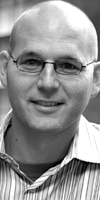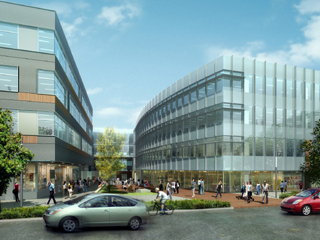
DJC.COM
February 14, 2008
Dead-end street to get an urban makeover
NBBJ

McDaniel
|
How can we create an urban office campus that acts sustainably, improves the public realm and makes a beautiful workplace? This is the question that the Yale Campus development and design team asked itself at the beginning of the design process.
The Yale Campus is a 776,000-square-foot office, retail, biotech and life-sciences project in South Lake Union being developed by The Blume Co. The campus has two parts. Yale Campus North will be located on two blocks between Eastlake and Pontius avenues, north of Mercer Street. Yale Campus South will be located on the full block bounded by Pontius, Mercer, Yale Avenue and Republican Street.
The project will provide 201,000 square feet of office space in two existing buildings and 575,000 square feet of office and retail in four new buildings.
The design team developed three major strategies to create sustainable and beautiful designs that enrich the tenants, the buildings and the neighborhood.
Take back the street

Image courtesy of NBBJ/Crystal Bioswales will flank the streets around Yale Campus South and filter stormwater runoff. The swales also buffer the plaza and sidewalk from the street. |
The Blume Co. embraced the concept that lively pedestrian-oriented streets are key to making livable urban neighborhoods, and the Yale Campus will extend the vital retail area that starts several blocks south at REI and Alley24.
Yale Campus North takes the transformation of the street one step further by changing a dead-end block into a “woonerf,” which is a Dutch term that means a “street for living.”
In a woonerf, pedestrians take precedence over cars. Speed limits, for example, are set extremely low and other design features are intended to slow down cars. The hard lines between the street and sidewalk blur, making the street into a large plaza, integrating new construction with the existing campus buildings.
Because this block of Yale dead-ends into the Interstate 5 on-ramps and traffic is limited, it creates an opportunity to transform the car-oriented street into a beautiful woonerf or plaza. This strategy reflects Seattle Department of Transportation’s recognition that streets serve more than cars — they serve people and neighborhoods.
Interestingly, the design tactics that are being used to slow down the vehicular traffic in the woonerf tie directly to the Yale Campus’ second big strategy, which focuses on cleaning stormwater runoff through natural filtration.
Within the plaza cars are slowed down by a series of runnels — small troughs that carry captured water from the adjacent building rooftops and paved surfaces. These runnels carry the water in the street to a number of large planting beds that use plants to filter water.
The high-visibility striping of the runnels and the change in texture of the road surface are among the important traffic-calming strategies of the woonerf.
A ‘swale’ idea
Yale Campus South is also designed to add valuable open space to the neighborhood.
Instead of a woonerf, a plaza cuts through the middle of the block from east to west. Here again, water is collected from the rooftops of adjacent buildings and the outdoor plaza and distributed to two bioswales (think of your old fashioned drainage ditch with lovely plantings here).
The project will include two swales that run between the street and the sidewalk along Yale and Pontius. With the help of the sun, the plants and grasses filter out almost 95 percent of the suspended solids in the water before it is returned to Lake Union.
In addition to the sustainable benefit, the swales create a buffer that protects the plaza and the sidewalk from the street, improving the pedestrian experience and creating an urban oasis in the middle of South Lake Union.
The buffer both filters and cleans the street and building runoff, and helps the public to understand how important our water really is.
Enriching experiences
If the first two strategies were focused on making walkable and livable streets and plazas that give back to the neighborhood, the next strategy focuses on enriching the experiences of the tenants and users in the building.
Most people don’t know that elevators consume about 10 percent of a building’s energy. Buildings in turn represent 40 percent of the world’s carbon footprint, making elevators responsible for a whopping 4 percent of the world’s carbon footprint.
In a four-story building, many people would take the stairs if only the stairs were easily accessible, convenient and a pleasant experience. Few building owners today can afford to provide all of the required exit stairs and an additional stair simply for comfort.
In the Yale Campus we have combined the two. Across from each elevator is an open, glass-enclosed stair that puts a priority on giving people a convenient and pleasant alternative to the elevator.
While there are a myriad of other sustainable features designed into the Yale Campus, these three ideas, through their simplicity and visibility, demonstrate how a sustainable development approach can provide a vital and critical investment in the future of our city.
Nick McDaniel is an associate with NBBJ Architects and the designer for the Yale Campus project.
Other Stories:
- Charrettes evolve to help make projects lean and green
- Vancouver convention center goes for the gold
- Affordable green housing: a social, economic priority
- Reduce your footprint, starting with where you work
- Tapping a market by building green
- Let’s get pumped up about heat sharing
- New LEED standards help retailers go green
- What does sustainability mean in practice?
- When sustainability means putting people first
- Rising to the challenge of carbon neutrality
- Is LEED living up to its hype?
- New headquarters lets firm walk the green talk
- How one city is getting greener
Copyright ©2009 Seattle Daily Journal and DJC.COM.
Comments? Questions? Contact us.